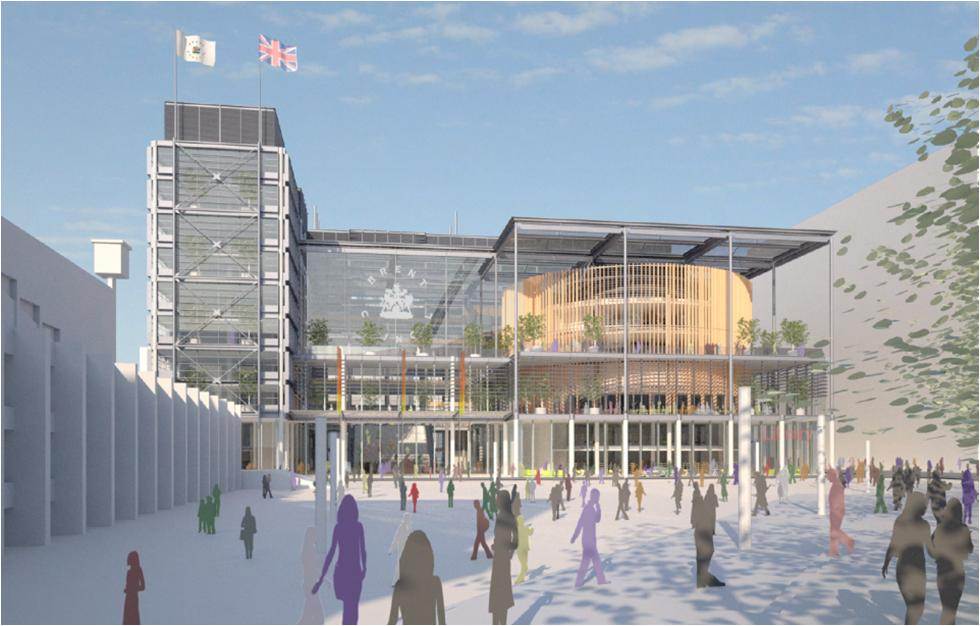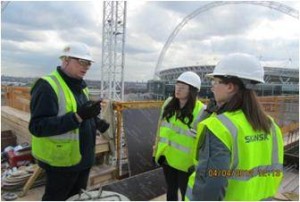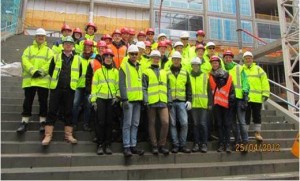Brent Civic Centre is an £85m public sector project located in the area of Brent, West London, near Wembley.
The building is designed by Hopkins Architects and the main contractor is Skanska. When completed, Brent Civic Centre will become the first public building in the UK to achieve a BRE Environmental Assessment Method (BREEAM) Outstanding rating, and join an elite group as one of the world’s most sustainable projects.
Brent Council, the client, set out a clear brief: to build the UK’s most sustainable public building. The benchmark for this objective was for the project to achieve a BREEAM Outstanding rating. In order to achieve this however, a willingness and a strong level of commitment from the client, main contractor and all other contracting parties was needed. The requirements for BREEAM Outstanding go beyond any standard requirements set out in, for example, building regulations and particular objectives need to be met in the design, supply chain, construction, and occupancy phases.
Genuine collaborative working, a fully integrated project team, community engagement, innovation in design, delivery and occupancy, and clearly defined contractual arrangements are key elements required to bring a project of this scale together. The JCT Design and Build Contract facilitated the solution.
Achieving BREEAM Outstanding
In order to achieve BREEAM Outstanding, a number of specific criteria must be met in respect of the building’s design, construction and performance. A minimum ‘A’ rated Energy Performance Certificate (EPC) CO2 index of 25 (0 is carbon neutral) must be obtained. Brent Civic Centre’s design stage submission indicated a CO2 index of 22.
In addition, for BREEAM bespoke 2008, a minimum of 85% of the available credits must be obtained. Once again, Brent Civic Centre aims to exceed this, currently targeting 94.8%.
Skanska’s green credentials
Skanska has a strong reputation for green building, which was highlighted when Skanska UK Chief Executive, Mike Putnam, delivered the JCT 2011 Povey lecture, “The Journey to Deep Green™”. In 2011 Skanska was named by the Sunday Times as the greenest company in the UK, across all industries. In his lecture, Mike Putnam spoke specifically about the Skanska Color Palette™, a communication and framework tool to demonstrate Skanska’s strategy for achieving ‘deep green’ and a representation of Skanska’s sustainable projects in the context of current industry standards.
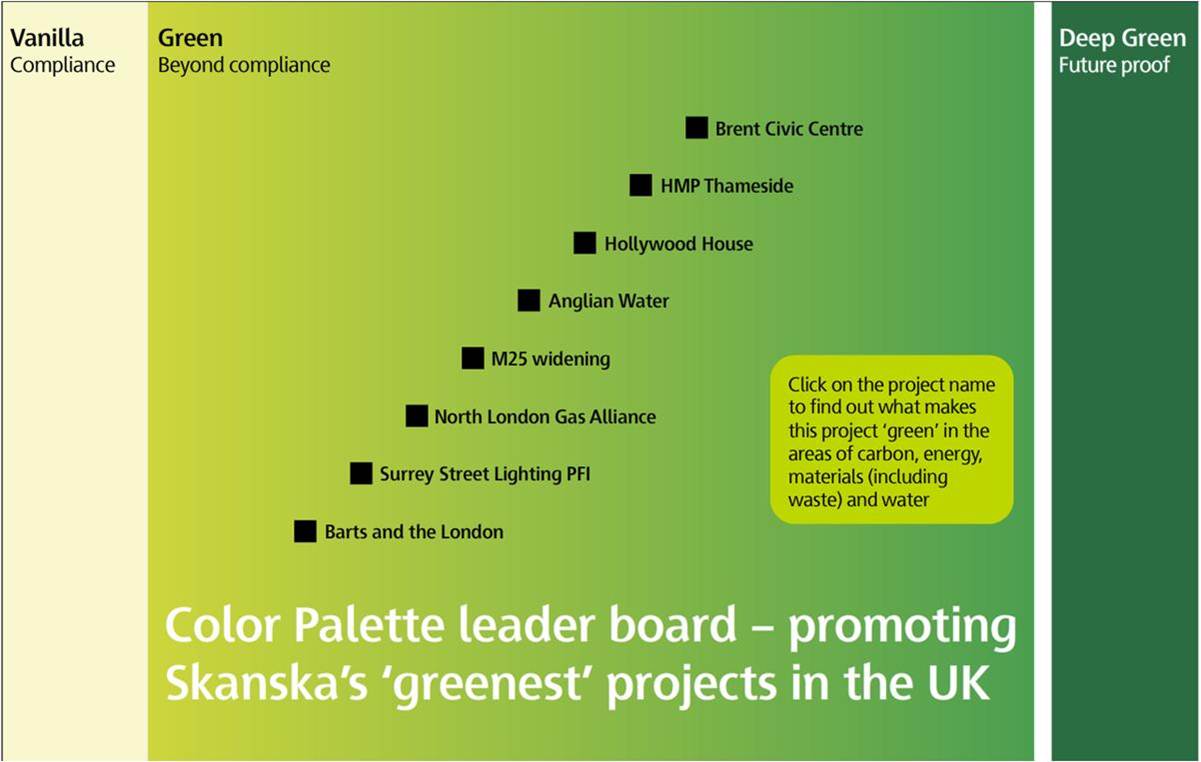
The above representation shows where Brent Civic Centre appears in relation to Skanska’s other UK projects. As well as highlighting Skanska’s overall commitment to sustainability across their range of projects, it clearly demonstrates how far beyond compliance the Brent Civic Centre goes in achieving its sustainable objectives.
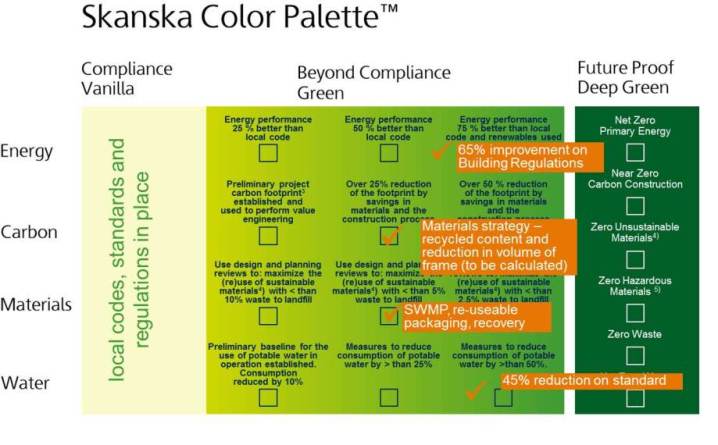
The above diagram shows the predicted forecast of sustainable performance of Brent Civic Centre mapped onto the Skanska Color Palette™. In terms of energy performance, the building is expected to be 65% more efficient than the standard set by current building regulations. Keeping the supply chain as local as possible, with the sourcing of local materials, using recycled content, tracking vehicle movements and a reduction in the volume of the building frame is predicted to reduce the carbon footprint of the project by 25%.
Less than 5% of waste is expected to go to landfill, due to the implementation of a Site Waste Management Plan (SWMP), along with a significant level in the use of recycled materials, including 50% recycled aggregate. The reduction in consumption of potable water is anticipated to be a 45% greater reduction than the standard, and BREEAM innovation credits have been awarded for an innovative water re-use system during construction.
Brent Civic Centre’s sustainable solutions
Several innovative solutions have been developed and brought together on the Brent Civic Centre Project in order to maximise its sustainable performance. These include:
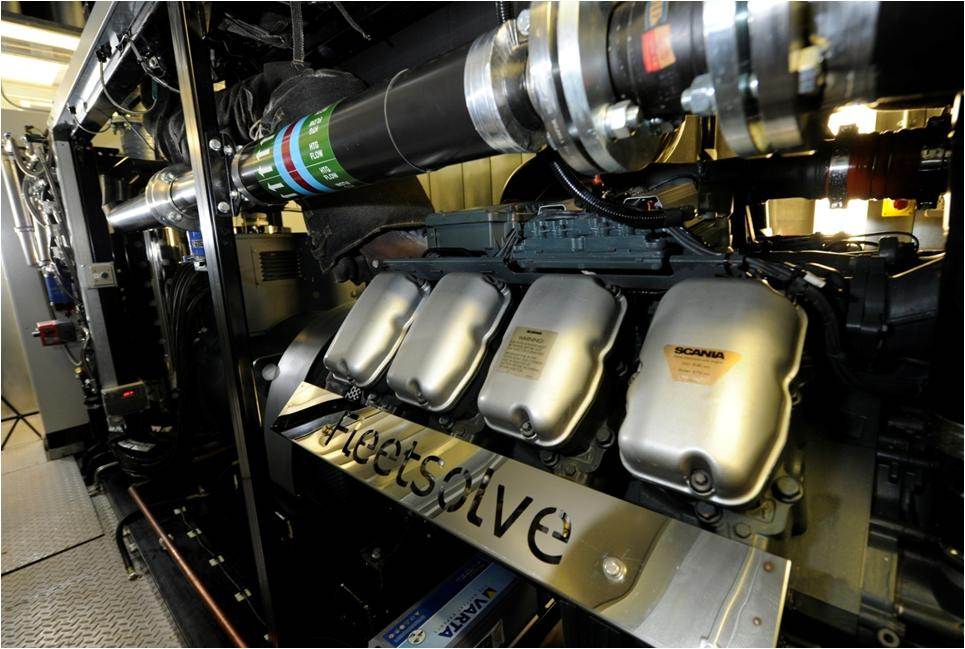
1. Bio-fuel Combined Heat and Power (CHP) Solution
- A multi-fuel design means the CHP unit can run on 11 different fuels. The plan is to use waste fish oil as the primary fuel.
- The solution can be run as a single modulating CHP engine, or a single absorption chiller.
- Customisation of the system means that it meets double the requirements for Ofgem and Renewable Obligation Certificate (ROC) accreditation.
2. Integrated Air Source Heat Pumps (AHU) and Whole Building COP
- Uses both pressure independent control valves and pressure independent controllable heat meters.
- A Remote Commissioning, Open Architecture Enterprise BMS system ensures that adjustments in water, heat and light can be made remotely from any location, and easy integration with other third-party solutions saves time, costs and energy.
3. Innovative Water Treatment Solution
- Freshwater use is reduced by 99% due to a rainwater harvesting system.
- Effluent use has been reduced by 99%, as well as reducing the risk of disposing effluent.
- Chemical usage has been reduced.
4. Construction elements
- 85% of the building structure is exposed as ‘fair-faced’ concrete. 50% of the aggregate is recycled, and the way it is finished means that extra materials, such as plasterboard, are not required.
- Passive design, with natural daylight and ventilation, and efficient building fabric helps reduce the need for artificial lighting and cooling.
Community Engagement
When Brent Civic Centre opens it will be a mixed-use public building which, as well as providing office space for 2,300 staff and councillors, will also provide quality community facilities, including an arts space, library, shops and eating facilities. The project team has been proactive in engaging the local community throughout the project from its inception. This not only includes the final users of the building, but also the supply chain, where the procurement of local materials and tender of packages of work to local businesses has been designed to keep as much of the spend within the community as possible.
A core priority of the project team however has also been to reach out to the community through education programmes and work opportunities. In total, by working through the council’s regeneration programme, the project team has been able to provide:
- Engagement with 926 students
- Engagement with 449 adults
- 47 weeks’ worth of work experience
- 838 weeks’ worth of training
Contractual Matters
Brent Civic Centre has been built using a JCT Design and Build Contract (2005 edition, revision 2: 2009). Integration of the design team through the construction phase is important for the project team, for which the JCT DB form provides.
The flexibility of the contract has also allowed for bespoke provisions to be written in respect of the sustainability requirements and in particular, the target of achieving BREEAM outstanding. Two clauses specifically highlight the contractor’s requirements, that they will a) use “all reasonable endeavours” to assist the employer in achieving 5 BREEAM credits, and b) the contractor themselves “shall obtain at least 108 BREEAM credits”.
As well as expressly detailing the requirements in the contract, it has also been the approach to the contract which has been a defining feature for the project. Brent Council’s Assistant Director – Civic Centre and Major Projects, Aktar Choudhury explained: “We have an excellent team from Skanska, which is making everything work very smoothly. We are delighted with progress made so far. We regard it as more of a partnership rather than a contract between two parties. It’s an open doors type of arrangement that we have. I can come and see the Project Director any time and likewise the Project Director can call me, so it’s a very good healthy relationship.”
Brent Civic Centre is an ambitious, landmark project that could set a benchmark for the way that the industry performs on future schemes. Sustainability is the key driver here, and striving for a BREEAM Outstanding rating is no doubt the key focus that has enabled this level of integration, team work, and communication to take place amongst all parties involved.
The example has been set by the project team with the contractual arrangements, which not only allow the requirements to be expressly set out, but also allow the parties to carry out the project in a way that is most effective to achieve the project’s ambitious targets. This communication has permeated throughout the project however, and the community engagement on a broader scale, coupled with the specific technical innovations, helps to reinforce the holistic approach to sustainability that this project represents.

